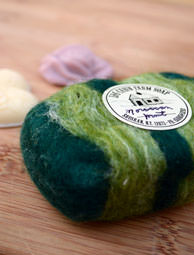
 Photo by Rachael Brugger Mary Urbielewicz uses sheep’s milk in her Log Cabin Farm Soap made in Shushan, N.Y. |
Cleopatra may be famous for her milk baths, but I personally can’t tolerate the smell of milk long enough to bathe in it! Fortunately, there’s an alternative way our skin can receive the benefits of milk. Using homegrown milk as ingredient in soap makes the cleanser gentler, creamier and more moisturizing.
“[Milk-based soaps] leave the skin soft and supple,” says Mary Urbielewicz, of Shushan, N.Y., who uses milk from a neighboring sheep farm for her Log Cabin Farm Soap line. Her customers who have eczema and psoriasis prefer milk soap because the milk softens the soap, making it less irritable to the skin.
“Goat’s milk has the same pH as human skin,” explains Martha Enriquez of Pine Lane Soaps in Batavia, Ohio. She adds 1 ounce of milk from her children’s 4-H Toggenburg and Saanen dairy goats to every 5-ounce bar she makes. Goat’s milk, she says, creates a bar of soap that is hard, long-lasting and gentle.
Adding milk to a soap recipe isn’t difficult, but you must take some extra steps to ensure a quality product.
Enriquez pasteurizes her milk in a home pasteurizer before use, whereas Urbielewicz prefers to use raw milk. Regardless, the milk must be frozen and thawed before it can be added to soap. Freezing the milk before use makes it stronger and more resilient to the hot lye that’s added during the soap-making process, keeping the mixture from getting too hot.
But don’t despair, if sheep or goat’s milk isn’t readily available on your farm or if it’s too pricey to source locally. It’s OK to use cow’s milk or powdered goat’s milk, as well.
“Any milk is going to give you a creamy complexion,” Urbielewicz says. “Milk is a wonderful addition. The difference is whatever else you put in it.”
Vegan Soap Ingredients
If you or your customers want a soap made without animal products, there are vegan substitutes that achieve the same skin-nourishing benefits as milk.
Naomi Murray, of Mountain Girl Soap and Sundries in northern California, uses an array of vegan ingredients—including shea butter, aloe vera gel, wheat germ, calendula and jojoba oil—in her handcrafted soaps. The shea butter, for example, is rich in vitamins A, E and F. For the liquid ingredients, she uses carrot juice (which is high in vitamin A), aloe vera juice and papaya nectar.
“These other liquids supply vitamins, antioxidants and minerals, reducing [skin] photosensitivity, promoting skin renewal and protecting from sun damage,” she explains.
Vegetable-based oils, such as olive oil, coconut oil, palm oil, castor oil, avocado oil, soybean oil and sweet almond oil, which Murray also uses in her soaps, offer many health benefits, as well.
“[They] are moisturizing and nourishing to the skin,” Murray says. “Soaps made with olive oil are mild and moisturizing and safe for sensitive skin and even babies.”
Plus, many vegetable-based oils don’t block skin pores, allowing the skin to breathe and continue sweating.
Get Started Making Soap
Whichever ingredients you choose to use, Enriquez says that soap making is “part art, part cooking and part craft.” Learn what soaps you like best by experimenting with different ingredients. Be patient—it may take you a few batches to get the hang of it! Use this milk-soap recipe to get started.
About the Author: Rebecca Shawhan is a happy farmer’s wife who lives in Hillsboro, Ohio. Along with gardening, she enjoys her team of Percheron draft horses, flock of 30 chickens and working on the family dairy farm.




